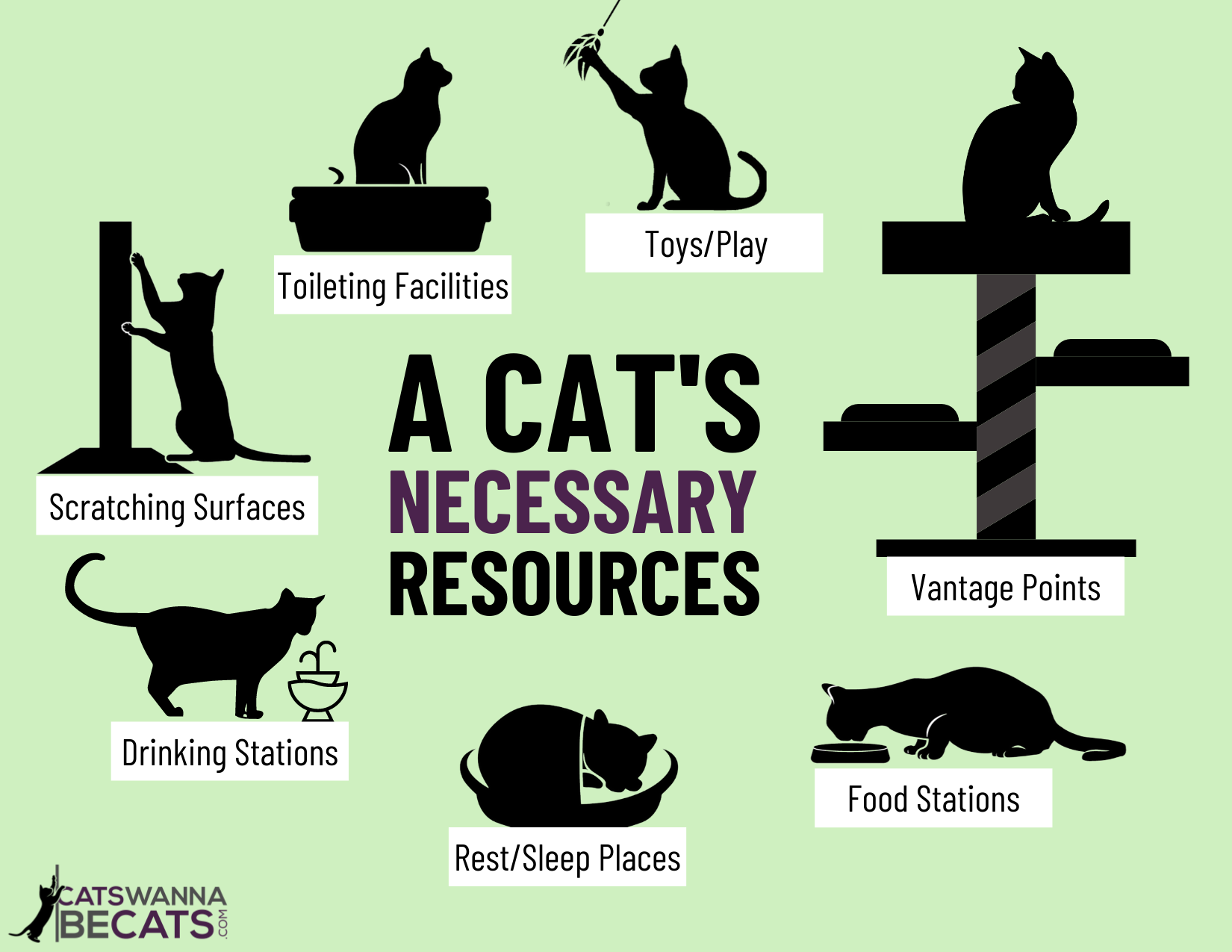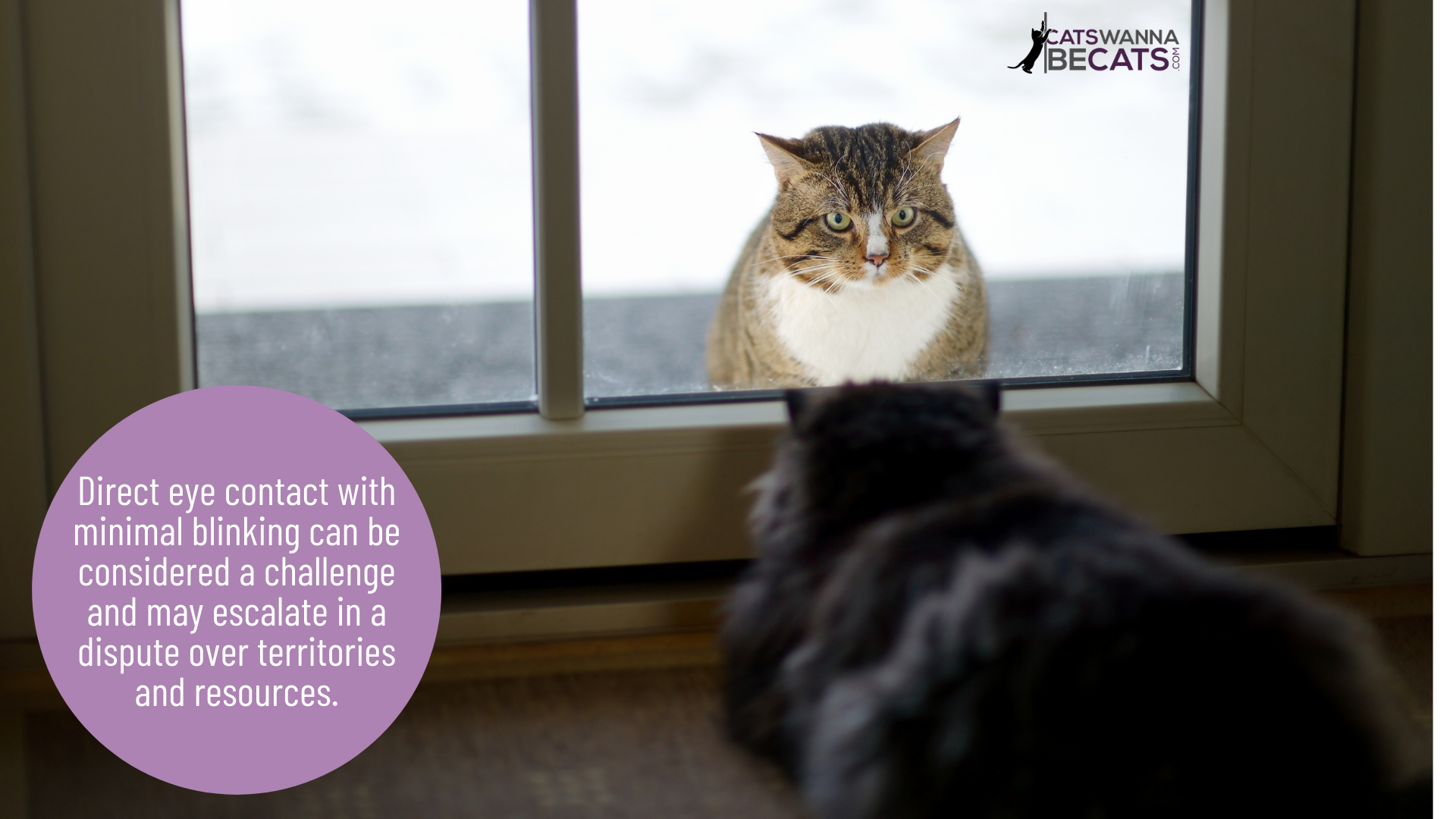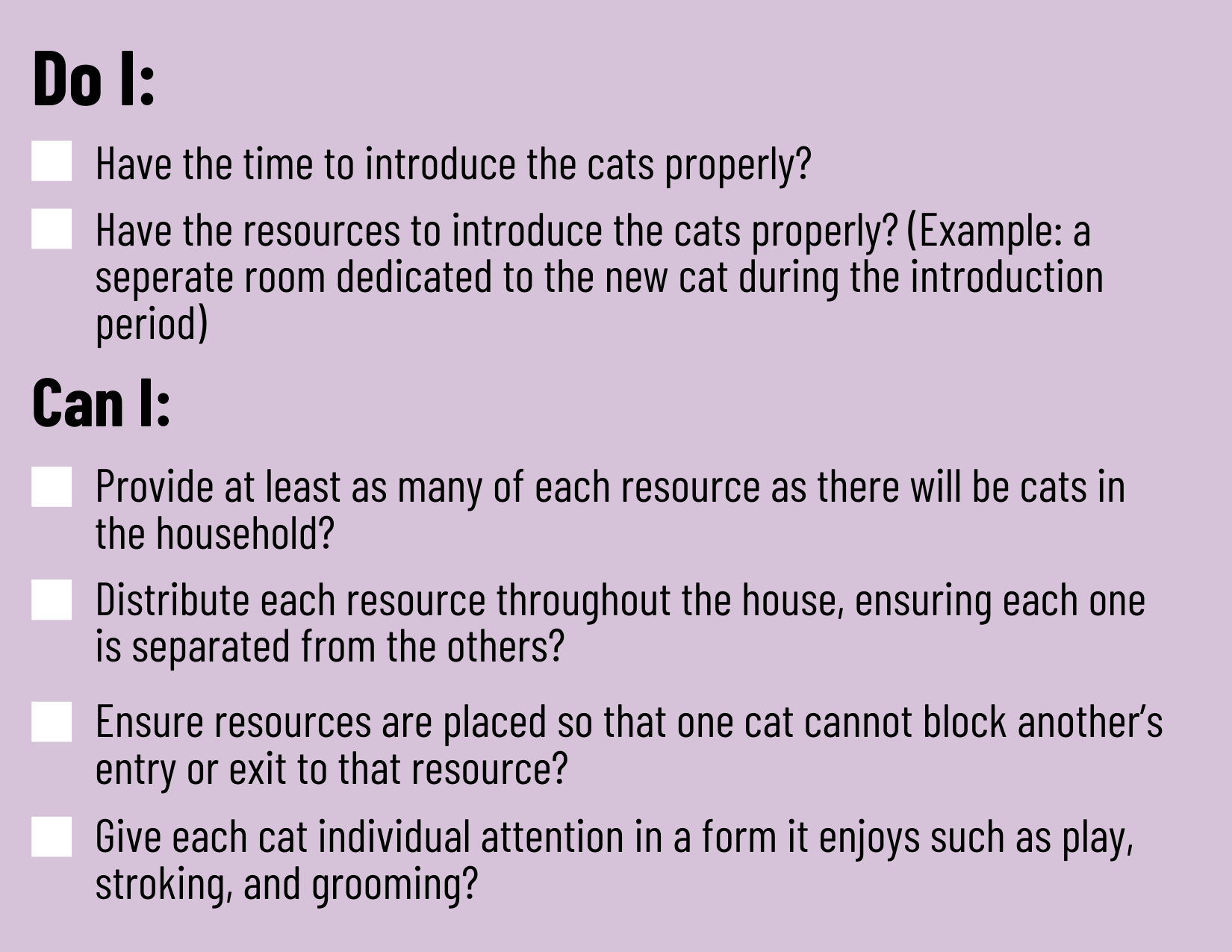Can your home support more than one cat?

As loving cat guardians, there is an important question we must ask ourselves: Would my cat(s) choose to live in my home if given the choice? Free-ranging and feral cats, for the most part, enjoy harmonious relationships within their social groups. Why? Well, largely because these social groups are self-selecting. Our domestic indoor cats, on the other hand, are not given the choice of where or with whom they live. While CatsWannaBeCats.Com advocates for keeping cats safe indoors and supervised or enclosed outdoors, we also acknowledge that very special care must be taken when introducing a cat to its new home and in determining whether or not this cat can live with other cats. And we don’t mean tolerate other cats – the standards must be higher. All cats within a home, solitary or as a group, should feel safe and content while enjoying the natural pleasures of being a cat.
We should strive to provide our cat(s) with homes they would choose to live in and additionally, in the case of multi-cat homes, social groups they would choose to live with.
This article focuses on whether current cat(s) in the household have the potential to accept another cat into the household based on factors relating to the resident cat(s).
Another important factor we will cover is whether the home (in the physical sense) is able to support another cat. By learning more about the needs of our feline companions both as a species and as individuals, we can better manage a harmonious multi-cat home or, as sometimes necessary, a peaceful single-cat home.
Are cats solitary or social?
Domestic cats have evolved from a solitary ancestor and currently, as a species, range from being highly solitary individuals to forming positive social relationships and co-existing successfully with other cats (if the conditions are favourable). They do not, however, need to rely on other cats for survival, as hunting is still very much a solitary activity. The cat’s territorial nature along with this lack of necessity to form social relationships mean that some would prefer to be the only cat in the household. Each cat is an individual on the matter.
All too often owners will bring home another cat or kitten to keep their existing cat company, only to find themselves in a difficult situation where neither cat is happy and the existing cat preferred life before the new one arrived. Before making the decision to introduce a new cat to your home and to ensure the addition will be a positive one for all, the following factors should be considered:
- Available space
- The provision of resources within this space
- The outside environment
How much space do cats need?
Being territorial means that some cats are not happy to share the same space as another and separate territories will be naturally created and maintained within the home. When bringing a new cat home, owners need to prepare for the possibility that the cats would rather avoid each other and accommodate this. Owners of multi-cat households need to provide adequate space to allow each cat to keep a social distance of 1 to 3 metres (horizontally as well as vertically) when they share a room.
What resources do cats need and how many?
A cat’s necessary resources include:
- resting and sleeping places
- toileting facilities
- food stations
- drinking stations
- toys
- scratching places
- vantage points
These resources are critically important to a cat and the type, number and distribution can greatly influence how a cat feels.
Cats that do not consider themselves part of the same social group will find it distressing to share resources. It is important to recognize that just because cats share a household, this does not necessarily mean they view themselves as part of the same social group. Therefore, when introducing a new cat(s), it is vitally important they have their own resources plus extras to ensure all cats have a choice of where to use these resources to help them avoid the other cats.

Problems can occur when only a single food and a single water station are provided within a multi-cat household. It can lead to a situation where each cat experiences the conflict of wanting to consume food but having to face or interact with other cats in the household in order to do so. This is particularly true when cats have set mealtimes as often all cats will congregate in the same space for food which can be particularly distressing for them. The fact that they will do it does not necessarily mean they prefer it this way.
Providing extra resources and feeding in separate areas will alleviate this source of conflict and will also reduce the competition for resources. The perceived threat to the territory will be reduced because of this and will help to increase the chances of the development of a positive social relationship between cats.
If the owners are not able to provide this required space and resources, the welfare of the new cat as well as the resident cat(s) may be compromised due to the social pressure forced upon them in the household.
How the outside environment impacts the cat(s) within the home
The social environment outside the home can be just as influential as the inside in determining a cat’s happiness. Often neighbourhood cats can be seen passing through or spending time outside the home of a resident cat. This is particularly true for urban areas where many houses and gardens are in close proximity and cats need to travel through multiple gardens to get to where they want to go. The presence of these unfamiliar cats can be intimidating for the resident cat and this can have consequences for their relationship with other cats within their home for several reasons:
- Firstly, the presence of cats outside may deter the resident cat from venturing out, limiting the amount of space they feel comfortable spending time in. In a multi-cat household, this will increase the social pressure within the home as there is less opportunity for the cats to avoid each other.
- Secondly, outside cats may approach and peer inside the home through windows or even come inside through the cat-flap. Again, this is going to be hugely intimidating and make it difficult for cats to cope inside the home.
- Finally, the presence of cats outside may trigger redirected aggression towards another cat in the household which could cause or exacerbate a breakdown in their relationship.
To keep your own cats safe while outdoors and to keep the neighbours’ cats at bay, you can try to catproof your yard. Here is a great DIY tutorial: https://www.instructables.com/Catproof-Your-Yard/
 This information is an extract from International Cat Care’s online course Cat Friendly Introductions: Cats, dogs and babies. If you are interested and would like to learn more about caring for cats at each life stage please visit International Cat Care’s Advice pages or consider enrolling in International Cat Care course – Cat Friendly Introductions: Cats, dogs and babies
This information is an extract from International Cat Care’s online course Cat Friendly Introductions: Cats, dogs and babies. If you are interested and would like to learn more about caring for cats at each life stage please visit International Cat Care’s Advice pages or consider enrolling in International Cat Care course – Cat Friendly Introductions: Cats, dogs and babies
Before introducing a new cat to your home, go through this checklist
These questions make a good checklist to consider before thinking about obtaining another cat in terms of whether the home is able to support more than one cat. If the answer is “No” to any of the following questions, then the likelihood of the cat(s) coping with a new cat(s) is diminished. The more “Nos” the less likely the current cat(s) will learn that the new cat(s) is not a threat.
Hopefully, this article has helped you to understand whether or not your home can support another cat or how to improve the environment within an existing multi-cat household – making it one your cats would choose to live in if given the choice.
“At International Cat Care we believe in a world in which each cat’s life experience will be as good as it can be. We do this by providing cat owners, veterinary professionals and those that live and work with cats with the resources, support and advice they need to care better for their cats.”
For more information, please visit http://www.icatcare.org or https://www.facebook.com/icatcare






